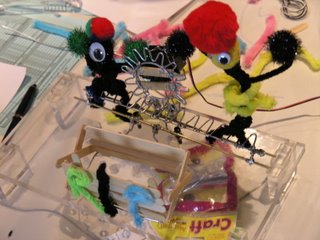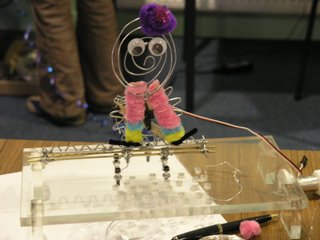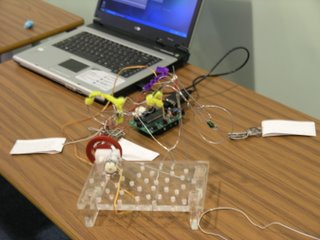A public space is public when it either maintains the public order or changes it, (Vito Acconci).
The public gathers in two kinds of spaces. The first is a space that is public, a place where the public gathers because it has a right to the place; the second is a place that is made public, a place where the public gathers precisely because it doesn’t have the right – a place made public by force, (Vito Acconci).
Although Acconci was talking about space -- parks, streets, buildings, etc. -- I feel that these ideas also apply to public vs. private information, to the concept of internet, to creative commons vs. copyright. Virtual space. Not to sound like a digital utopian/net-o-phile/whatever, but it's true that the internet has changed the way we think about some fundamental concepts, and I feel that when viewing the internet as a public space through the lens of Acconci, it's possible to see how it falls into the two categories.
I guess that maybe I'm not the person who knows best about this. All I know is the stuff that has gotten hashed out in two semesters of CMS classes (thanks, Henry :) ), but it's something I think about, and is something I care about, so maybe I can still have something to say in the matter even though it's not really my area of study.
The internet. In some ways, I can barely remember the time I didn't have it. But even though the memory is vague, I remember the first webpage I made -- in fact, it was the first thing that came up when you searched for my name for a long time. I remember when I used to get games via BBSs. I remember shareware and Duke Nukem and Crystal Caves and Commander Keen. I remember my first computer -- an Atari. And, in some ways, I realize my generation's role as the first people to have pretty much grown up with computers. I used to be fascinated by the screeching sounds of the modem communicating to another computer. So horrible, yet so wonderful at the same time. In some ways, it's still the sound of the future for me. I remember some of the first CD drives for PCs. I remember building my first computer. I still use my AOL screen name from 6th/7th grade. I've been around computers so long, that I take them for granted, take the knowledge of how to use them as something everyone knows. Well.. at least all my friends know. So I'm always surprised when my step-mom or my mom or my dad don't know about things. I introduced my dad to flickr. He's decided to get a paid account now. I find this really amusing.
But back to information. Transfer of information. That's what the internet is good for. I can find people who have my same interests all over the world. I can buy toys from my childhood (thanks to ebay). All of this and more has led to the growth of the long tail economic model. Lots has been said about this, and I don't know that I can really say any more interesting things than have already been said. So back to Acconci. "The public gathers because it has a right to the place." Take away this right, and you take something unique about the internet away.
I get really frustrated reading about the whole net neutrality debate. Particularly from the standpoint that our politicians are so distanced from society/technology, that they really seem to have no clue. Or at least most of them seem this way. Jon Stewart has definitely made fun of this one a lot. But, seriously, I listen to them talk and it's obvious that they don't really know things. And I also think that this whole concept of internet, of connectivity across the world, is just at its beginnings. So much that we don't know, so many uses left to be found -- uses that can only be made by people who use the internet. The uses of the street. The uses of the public.
The internet allows people to redefine public. It allows fan communities to form. It allows niche groups to have a say. In some ways, it has the potential to be a wonderful tool for democracy. The internet is very much a place for the public.
The internet is also a place where the public can reclaim things made private. Piracy, mp3s/file sharing, open source software, etc. These are all reclaimations of privatized information. The internet is a place where information can be "made public by force"... the force of numbers. The force of anonymity. The force of the public.
The space that is made public began as its own opposite, This was a space that was never meant to be public at all: a royal space, or a presidential space, or a corporate space. This private and privileged space had inherent in it, from its beginning, the seeds of public space: the fact of its existence provoked desire, its privacy functioned as a taunt to the public that felt left out. Once that space has been taken over by force and made public, it has inherent in it, in turn, the seeds of private place, the seeds of re-defined and re-inhabited privacy: the public that takes it over is working its way up to the royalty or the presidency or the corporate office. Private space becomes public when the public wants it; the public space becomes private when the public that has it won’t give it up, (Vito Acconci).
\\--------------------------------------------------------------//
In the space that is public, the public, whose space this is, has agreed to be a public, these are people “in the form of a city”, they are public when they act “in the name of the city”. They “own” the city only in quotes. The establishment of certain space in the city as “public” is are minder, a warning, that the rest of the city isn’t public. New York doesn’t belong to us, and neither does Paris, and neither does Des Moines, (Vito Acconci).
No one owns the internet. No one should own it. And I think there's a very interesting interplay of public vs. private on the internet. In some sense, it's a space that everyone has agreed is "public." But it's also a space where propriety of information -- privacy, of sorts -- comes into play. Hacking websites isn't "allowed." I mean... it can be done, but it's messing with someone's own "private" place. Even though everything about the webpage (the source and the styles and the images, etc) are all open for the public to see. Blogs. Blogs are some place I find the interplay of public and private most interesting. There are all these teenagers (I reserve the right to talk about them because I once was one of them) who post their most inner feelings for all to see. Often involving overly-done and melodramatic poetry. Possibly a black background on their journal. In some ways, by showing it to people who are numeros and anonymous, it's almost like privacy. At least, I never got worried about posting things in my journal until my friends found it. And then I would change journals, or make private entries, or something along those lines.
And, you know, to this day I still find this concept of anonymity to be important. Especially when it comes to showing my sketchbook. I would rather show my sketch book to a complete stranger than to my parents. Or my friends, usually. The distance is somehow soothing. Everything becomes more objective. And in some ways, it's just a different form of performing. I can only perform when I can't see the audience, when I don't have a connection to the audience.
\\------------------------------------------------------//
Public space, in an electronic age, is space on the run. Public space is not space in the city but the city itself. Not nodes but circulation routes; not buildings and plazas, but roads and bridges. Publicspace is leaving home, and giving up all the comforts of the cluster-places that substitute for the home. Space on the run is life on the loose. There’s not time to talk; there’s no need to talk, since you have all the information you need on the radio you carry with you. There’s no need for a person-to-person relationship, since you already have multiple relationships with the voices on your radio, with images of persons in store windows and on billboards; there’s no time to stop and have a relationship, which would be a denial of all those other bodies you’re side-by-side with on the street, one different body after another, one body replacing another. There’s no time and no need and no way to have “deep sex”: in a plague year, in a time of AIDS, bodies mix while dressed in condoms and armored with vaginal shields – the body takes its own housing with it wherever it goes, it doesn’t come out of its shell. The electronic age and the age of AIDS come intermixed in an age of virus, whether that virus is information or disease. Each person becomes too infected, either with information or with disease, to be with another. You come to visit, not to stay, (Vito Acconci).
I felt this last night when I didn't feel safe to stop anywhere to sit and eat a dinner.
Why does the concept of ownership feel so foreign to me?
A 30 minute drive away might have well been another country.









